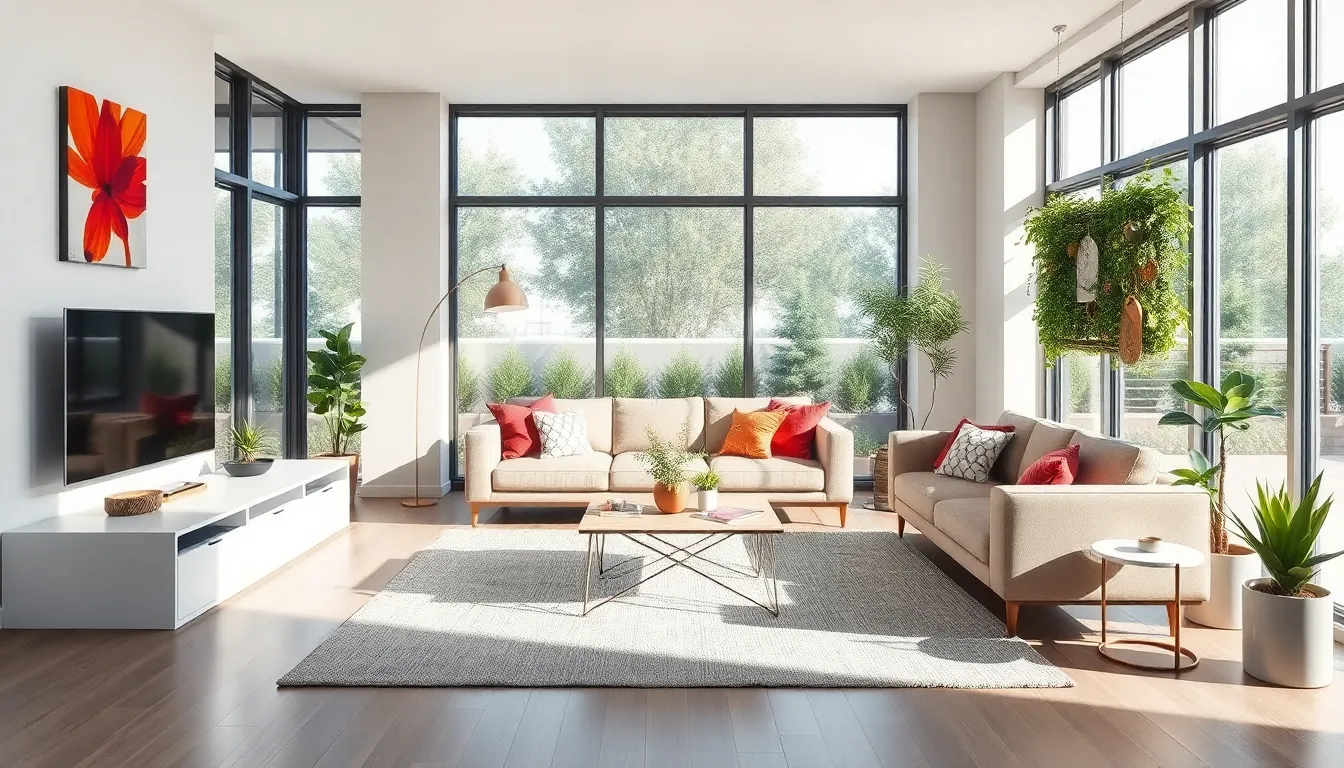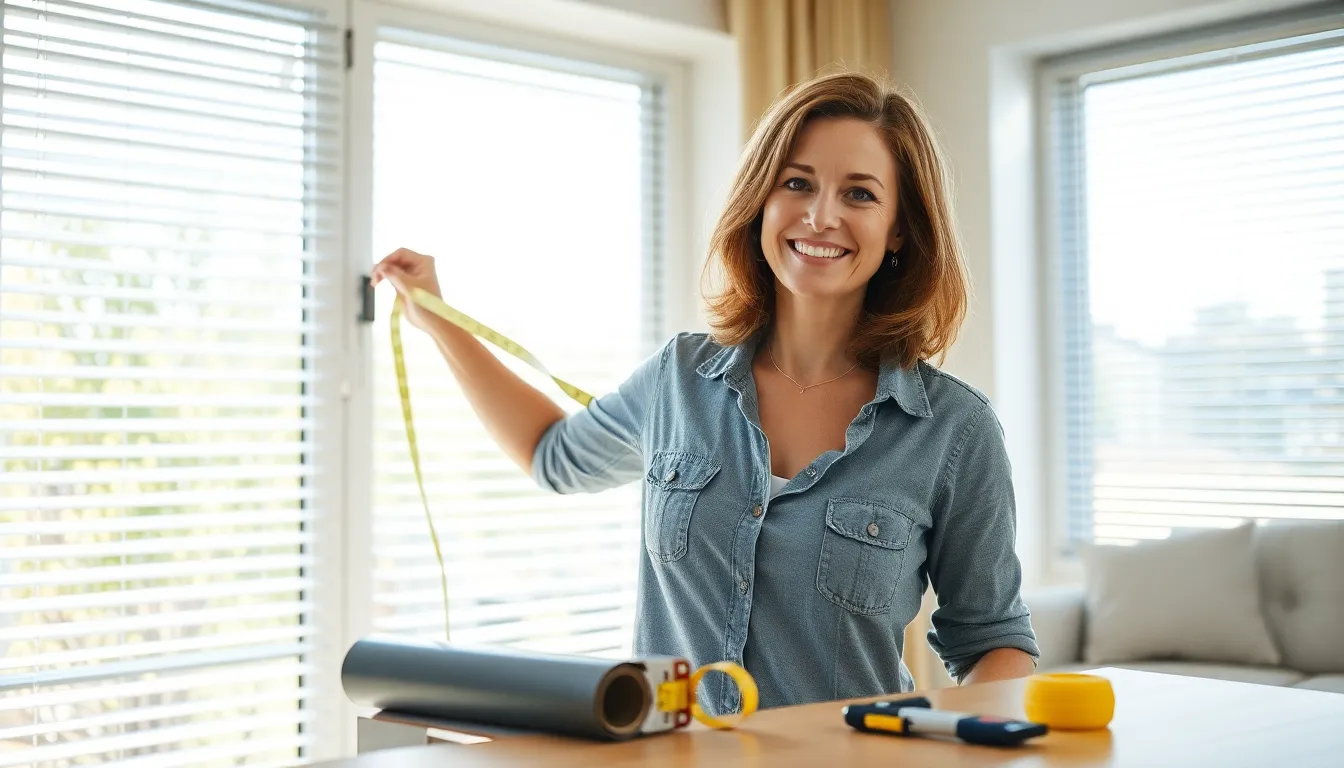In a world where home is more than just a roof over one’s head, contemporary home elements are taking center stage. They blend style and function, making living spaces not just livable but downright delightful. Imagine a home that feels like a cozy café, complete with a touch of sleek minimalism and a dash of bold color. It’s the perfect recipe for a space that’s as inviting as it is Instagram-worthy.
Table of Contents
ToggleOverview of Contemporary Home Elements
Contemporary home elements blend aesthetics with practicality, forming spaces that resonate with personal style and modern living needs. Clean lines define architectural designs, promoting simplicity and elegance in home environments. Natural light plays a crucial role, enhancing openness and creating inviting atmospheres that encourage relaxation.
Materials often feature glass, steel, and sustainable wood, underscoring eco-friendly choices that appeal to conscious consumers. Color palettes emphasize neutral shades, accented with vibrant hues to add character without overwhelming the senses.
Furniture choices prioritize minimalism, often incorporating multifunctional pieces that save space while maintaining style. Textures enhance visual interest, creating layers through fabrics such as velvet, leather, and organic cotton.
Outdoor spaces receive attention, emphasizing the connection between interiors and exteriors. Balconies, patios, and gardens offer additional living areas, with many homeowners opting for vertical gardens and sustainable landscaping practices.
Art and decor play significant roles in contemporary homes, reflecting personal tastes and fostering individuality. Thoughtful placement of artwork and unique decor pieces adds character to open layouts, making the space feel curated and inviting.
Technology integrates seamlessly into these living spaces, with smart home features enhancing convenience and efficiency. Smart lighting, thermostats, and security systems promote energy savings while offering modern functionality.
Form and function work together in contemporary homes, creating environments where practicality meets style. Each element contributes to an overall experience that prioritizes comfort, sustainability, and personal expression.
Key Features of Contemporary Design

Contemporary design emphasizes a harmonious blend of aesthetics and functionality. Key features contribute to creating inviting living spaces.
Open-Concept Layouts
Open-concept layouts promote fluid movement between rooms. This design eliminates unnecessary walls, enhancing social interactions. Spaces feel larger and more cohesive, encouraging family gatherings and entertaining. Furniture arrangements adapt easily to various activities, making daily life more convenient. Homeowners often find that these layouts maximize light and airflow, fostering an airy atmosphere. Integrating various zones for cooking, dining, and lounging, these layouts cater to modern living needs.
Natural Light Integration
Natural light integration plays a crucial role in contemporary design. Expansive windows and glass doors create bright, uplifting environments. Spaces thrive on natural illumination, reducing reliance on artificial lighting. Skylights further enhance brightness, especially in darker areas of the home. Homeowners appreciate the connection to the outdoors, creating a more vibrant ambiance. This focus on light contributes to sustainability, as energy consumption decreases with ample daylight.
Popular Materials in Contemporary Homes
Contemporary homes often feature a range of materials that enhance style and function. These elements create inviting spaces that resonate with modern lifestyles.
Sustainable Materials
Sustainable materials define contemporary design, prioritizing eco-friendliness without sacrificing aesthetics. Bamboo flooring offers durability and a unique look, while reclaimed wood introduces character and history to spaces. Concrete serves as a versatile option, suitable for both flooring and countertops, providing an industrial feel. Metal elements, such as aluminum, add a sleek touch and are recyclable. Many homeowners also incorporate natural fabrics, like organic cotton or linen, in upholstery and textiles, ensuring a low environmental impact.
Textures and Finishes
Textures and finishes introduce depth and interest in contemporary homes. Smooth surfaces, like polished concrete and glass, create a refined aesthetic, reflecting light and adding a sense of spaciousness. Contrastingly, rough textures, such as exposed brick or reclaimed wood, add warmth and a tactile quality. Matte finishes on walls or cabinetry provide a modern look, while glossy finishes can highlight design features. Incorporating a mix of these textures allows for a dynamic and engaging environment, catering to different senses and enhancing overall comfort.
Color Palettes and Aesthetic Trends
Color palettes in contemporary homes prioritize balance between neutral tones and bold accents. These combinations create visually engaging and stylish environments that appeal to modern sensibilities.
Neutral Tones
Neutral tones serve as the foundation for contemporary design. Shades such as beige, gray, and soft white create a serene backdrop that enhances natural light. Many homeowners choose these colors for their versatility, allowing flexibility in decor and furnishings. Interestingly, muted neutrals establish a calming atmosphere, perfect for promoting relaxation. Various textures within these tones add depth, enriching spaces without overwhelming them. The trend toward open-concept layouts benefits significantly from these shades, making them a popular choice in contemporary design.
Bold Accents
Bold accents bring life to otherwise subdued environments. Colors like deep blue, vibrant green, and rich mustard create focal points that capture attention. One popular approach features accent walls painted in dramatic hues, enhancing the visual interest of a room. Furniture and decor in bright colors complement neutral backdrops, establishing a cohesive aesthetic. Many designers advocate for using bold accents sparingly to maintain balance while still expressing personal style. These elements not only energize a space but also serve as conversation starters, making homes feel distinctly inviting.
Functional Elements in Contemporary Spaces
Contemporary spaces blend functionality with modern design, emphasizing practicality without sacrificing style.
Smart Home Technology
Smart home technology revolutionizes how people interact with their living spaces. Voice-activated assistants streamline daily tasks, providing convenience at the touch of a button. Automation features control lighting, temperature, and security, enhancing comfort and safety. Integration with mobile devices allows users to monitor their homes remotely, offering peace of mind. Energy-efficient systems contribute to sustainability, reducing utility bills while minimizing environmental impact. Each element enriches the living experience, making homes smarter and more adaptable.
Multi-Functional Furniture
Multi-functional furniture maximizes space while maintaining aesthetic appeal. Sofas that convert into beds provide flexibility for hosting guests without compromising comfort. Nesting tables offer versatility, allowing for easy rearrangement when entertaining. Storage ottomans combine seating with concealed space, keeping rooms organized and clutter-free. Desks that fold away when not in use create more open areas, especially in smaller homes. Every piece serves multiple purposes, addressing the needs of modern living while enhancing the overall design.
Contemporary home elements reflect a harmonious blend of style and function. They create inviting spaces that cater to modern living while showcasing personal taste. The emphasis on sustainability and smart technology enhances both comfort and efficiency, making homes not just beautiful but also practical.
As design trends continue to evolve, these elements will likely adapt, further enriching the connection between indoor and outdoor living. With thoughtful choices in materials, color palettes, and furniture, homeowners can craft environments that are uniquely theirs, embodying the essence of contemporary living. This approach not only elevates aesthetics but also fosters a sense of well-being, making every home a true sanctuary.








